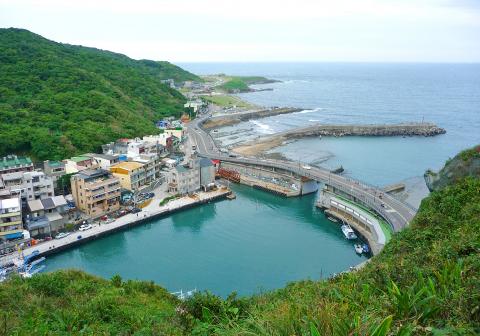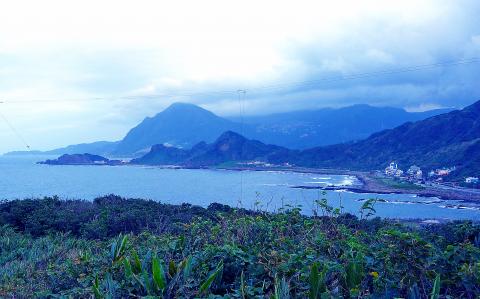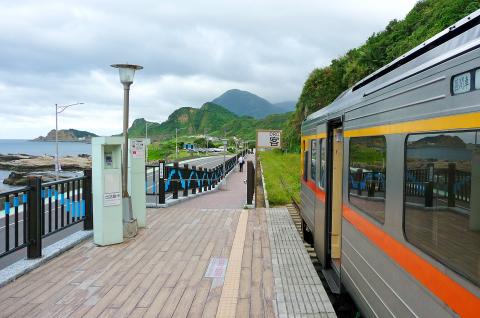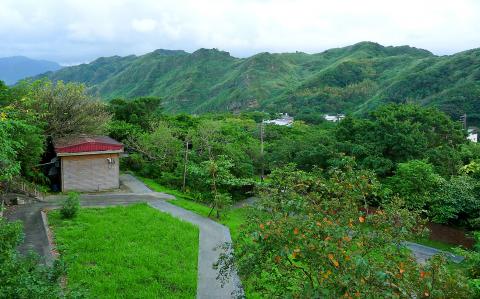The hinterland of Keelung has at least four tourist magnets. The best known, of course, is Jiufen (九份). The nearby Jinguashi Gold Museum (金瓜石黃金博物館) is another. Houtong Coal Mine Ecological Park (猴硐煤礦博物園區) and the Pingxi Branch Railway (平溪支線) complete the quartet.
The coastal community of Badouzi (八斗子) has two advantages over all of these places. It’s slightly closer to central Keelung — a blessing if you’re pressed for time — and it’s never totally overrun by tourists. What’s more, you can arrive via one form of public transportation, and leave by another, thanks to the reopening of the Shenao Branch Railway (深澳支線).
The Shenao branch line has more than 80 years of history. From 1936 to 1962, a railroad hugged the coast between Keelung and Shuinandong (水湳洞) via Badouzi and Shenao (深澳). Shuinandong is these days best known for its Golden Waterfall (黃金瀑布), a cascade that gains its photogenic hue from minerals washed out from the hill behind.

Photo: Steven Crook
The railway was built to serve the mining industry, but gold and copper extraction dwindled after World War II. However, its closure in 1962 turned out to be temporary. The authorities bored a pair of short tunnels so part of the branch line could be connected to Ruifang (瑞芳), and in 1965 coal-carrying trains began rolling between Ruifang and the Shenao Power Plant (深澳發電廠). Lauded at the time as a state-of-the-art power station, the plant met more than a third of Taiwan’s electricity needs throughout the late 1960s.
Passenger trains used this railroad until 1989, and trains continued to deliver coal until the power station was shut down in 2007. But none of this need concern the average person hoping to see some enticing scenery without investing a lot of physical or mental effort. One way to begin the trip is by taking the regular 1061 or 1062 bus from Zhongxiao-Fuxing MRT in central Taipei to Ruifang (瑞芳). Yilan-bound express trains are a quicker alternative.
From Ruifang TRA Station, a three-car diesel-electric train sets off for Badouzi eight times daily on weekdays. On Saturdays and Sundays, there are 10 services per day. Each train actually starts out from Jingtong (菁桐), the western terminus of the Pingxi Branch Railway, halting at Shifen (十分) and Houtong (猴硐) before pausing at Ruifang.

Photo: Steven Crook
I’ve taken the Shenao Branch Railway twice in the past few months. On the first occasion, I rode it all the way to the coastal terminus, Badouzi TRA Station (八斗子火車站). This station straddles the boundary between Keelung and New Taipei City, and from the platform there are fine views of a bay that’s 2.3km across at its widest. The promontory to the east includes Shenao Elephant Trunk Rock (深澳象鼻岩).
Each train halts for about half an hour at Badouzi TRA Station before returning to Ruifang, giving those aboard plenty of time to take snaps, or dash down to the water’s edge, before reboarding. And this is what the vast majority of passengers do; the station’s location means it’s of no use to commuters. To reach the busier parts of Badouzi, one has to walk at least 1.5km. Nor is the station very convenient for those who plan to head further east by public bus, the nearest bus stops being more than 200m away.
When I had an opportunity to return to this corner of Taiwan for a few hours, I took the train from Ruifang to Haikeguan (海科館), the only other stop on the Shenao Branch Railway. Haikeguan is 4.2km and a mere nine minutes from Ruifang; Badouzi is 500m (two minutes’ travel time) further down the line.

Photo: Steven Crook
There are two good reasons to disembark at Haikeguan. One is to visit the landmark after which the station is named, the National Museum of Marine Science and Technology (國立海洋科技博物館). The museum is open Tuesday to Friday from 9am to 5pm, and until 6pm on weekends. For those aged over 12 but under 65, admission is NT$200; 6 to 12-year-olds pay NT$140; kids under six enter for free.
The other attraction is a hiking trail that’ll please anyone in a “minimum effort, maximum return” mood. The Rongxuan Trail (容軒步道) connects the station to a hilltop less than 10 minutes’ away. From it, the 360-degree view includes the marine museum, Keelung’s Heping Island (和平島) and Jiufen to the southeast.
At the top, I not only enjoyed the panorama, but also learned a fair bit from bilingual information panels. I had no idea that the rugged headland immediately north of me was an island until the 1930s. The Japanese colonial authorities filled in the trench between the island and the “mainland” so they could build a power station. The plant burned coal until 1981. Much later, its shell was repurposed into part of the marine museum.

Photo: Steven Crook
Another panel explains past and present toponyms in the area, the most memorable being Huanfan (換番, “exchange with savages”). Long ago, it was a no-man’s land where members of the lowland Ketagalan tribe would meet and barter with Han merchants.
Here, as elsewhere, Ketagalan culture lies buried beneath layers of Han settlement, industrialization and modernization. Their name at least lives on in school textbooks and official publications like the panels along Rongxuan Trail. Reminders that Taiwan has for hundreds of years been a multiethnic society now seem to be everywhere. I, for one, think this is a good thing.
Steven Crook has been writing about travel, culture, and business in Taiwan since 1996. Having recently co-authored A Culinary History of Taipei: Beyond Pork and Ponlai, he is now updating Taiwan: The Bradt Travel Guide.

We lay transfixed under our blankets as the silhouettes of manta rays temporarily eclipsed the moon above us, and flickers of shadow at our feet revealed smaller fish darting in and out of the shelter of the sunken ship. Unwilling to close our eyes against this magnificent spectacle, we continued to watch, oohing and aahing, until the darkness and the exhaustion of the day’s events finally caught up with us and we fell into a deep slumber. Falling asleep under 1.5 million gallons of seawater in relative comfort was undoubtedly the highlight of the weekend, but the rest of the tour

Youngdoung Tenzin is living history of modern Tibet. The Chinese government on Dec. 22 last year sanctioned him along with 19 other Canadians who were associated with the Canada Tibet Committee and the Uighur Rights Advocacy Project. A former political chair of the Canadian Tibetan Association of Ontario and community outreach manager for the Canada Tibet Committee, he is now a lecturer and researcher in Environmental Chemistry at the University of Toronto. “I was born into a nomadic Tibetan family in Tibet,” he says. “I came to India in 1999, when I was 11. I even met [His Holiness] the 14th the Dalai

Following the rollercoaster ride of 2025, next year is already shaping up to be dramatic. The ongoing constitutional crises and the nine-in-one local elections are already dominating the landscape. The constitutional crises are the ones to lose sleep over. Though much business is still being conducted, crucial items such as next year’s budget, civil servant pensions and the proposed eight-year NT$1.25 trillion (approx US$40 billion) special defense budget are still being contested. There are, however, two glimmers of hope. One is that the legally contested move by five of the eight grand justices on the Constitutional Court’s ad hoc move

Stepping off the busy through-road at Yongan Market Station, lights flashing, horns honking, I turn down a small side street and into the warm embrace of my favorite hole-in-the-wall gem, the Hoi An Banh Mi shop (越南會安麵包), red flags and yellow lanterns waving outside. “Little sister, we were wondering where you’ve been, we haven’t seen you in ages!” the owners call out with a smile. It’s been seven days. The restaurant is run by Huang Jin-chuan (黃錦泉), who is married to a local, and her little sister Eva, who helps out on weekends, having also moved to New Taipei